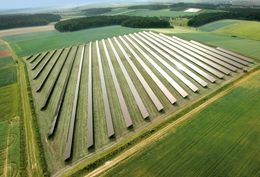



Solar farms are sprouting up all over America. The 30% Federal energy tax credit, combined with state, utility and local solar incentives have created an extremely favorable climate for investment in solar farm technology.
Solar farms can take many forms. The most common is the PV or photovoltaic solar farm that is built from hundreds or thousands of solar panels mounted on large racks in a field, pasture or desert parcel. Want to discuss a solar farm? Speak now with an installer - 877-331-1235
Installation of solar panels on the scale required for a solar farm is a big task. But like most engineering projects, the installation of a solar farm is made simpler by breaking down the project into its component parts.
Site assessment
Financing
Solar Thermal
Most early solar farms (and a number of very large-scale current solar farms) were built using solar thermal technology. Thermal solar farms use a series of mirrors to concentrate the sun’s heat onto a central column that uses the high temperature to create steam, which then spins a turbine to make electricity (interestingly, it's the same turbine technology used in hydroelectric, nuclear, geothermal and coal burning plants that generate electricity.)
Photovoltaic (PV)
Photovoltaic solar farms use hundreds or thousands of panels covered with photovoltaic cells to convert the sun’s light directly into electricity. They generate more power when daylight lasts longer - during summer months and in the south.
Stationary vs Tracking
Solar farms that use PV technology may install stationary or rotating panels in rows. The more panels, the more space is needed - and the more electricity is generated.
Thermal solar farms install collectors - mirrors (heliostats), dishes, reflectors and troughs - that move to track the sun’s path across the sky.
Solar Farm Site Assessment
A PV solar farm can range from a few acres to hundreds of acres in size. They can be found across the country.
A thermal solar farm can be small but most are large - in the thousands of acres. Most are found in desert areas.
Soil composition, water access, and proximity to power lines and substations all play a part in the selection of a site. Zoning issues affect the location of solar farms. Landowners’ legal rights to contract for long terms can influence site selection between private and federally owned land.
Solar Farm Financing options
To get an installation built, most solar farms rely on a combination of loans and grants from both public and private sources. National programs run by government lenders such as the U.S. Department of Agriculture and the U.S. Environmental Protection Agency are one source of financing. Private investors and public/private partnerships are typical sources of funds. Other options that may be part of the financing deal include leasing land from a user of the solar power generated by the farm.
Solar Farm Incentives
Rebates and tax credits can help defray the costs of solar farm installation. Feed-in tariffs and solar renewable energy certificates can help make the operation of a solar farm profitable.
877-331-1235 | © Copyright DASolar.com.